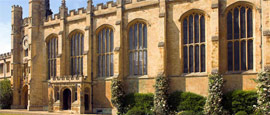Cambridge University is the second oldest university in England, and shares an unrivalled reputation for excellence and tradition with Oxford University. The university's various colleges, many of them architectural masterpieces, are scattered throughout the city. Many are partially open to visitors at certain times. A board at the entrance lists opening times; otherwise ask at the tourist office.
Things to see in Cambridge
Tourist offices
Address: Peas Hill (off Market Place), Cambridge, CB2 3AD, United Kingdom
Tel: +44 871 226 8006.
Opening Hours:Mon-Sat 1000-1700, Sun 1100-1500 (April-Oct); Mon-Sat 1000-1700 (Nov-Mar). www.visitcambridge.org
The Visit Cambridge team can help with arranging accommodation and booking attraction as well as providing maps, souvenirs, tickets for King’s College Chapel, guided punt tours and more.
This world-class collection of Oceanic, Asian, African and Native American artefacts includes many full-sized extremely colourful items (canoes, sculptures, masks, totem pole) and is an exotic feast of images and well-presented ideas. Highlights include the largest collections of objects from the voyages of Captain James Cook and an impressive collection of Anglo Saxon material from Britain.
This atmospheric Norman survivor, albeit extensively renovated, is one of only four round churches in the country. It dates back to 1130AD, making it one of the oldest buildings in Cambridge, and hosts an excellent permanent exhibition on the impact of Christianity in England.
This charming and comprehensive museum, focusing on local social history and folklore, is housed in the former 16th-century White Horse Inn. Items in its collection include a wonderful mix of everything from the mundane to the bizarre, such as courting tokens made of corn, to moles’ paws carried to prevent rheumatism and an old-fashioned vacuum cleaner.
The fine old university church overlooks the market square and boasts a tower with a narrow vertiginous staircase that opens to look down on the heart of the medieval city. Its physical foundations date from around 1010 and a church has stood in this very spot since 1205.
The university's art collection provides the basis for one of the finest small museum-galleries in Europe, with art and antiquities spanning centuries and civilisations. Among the highlights are paintings from the 14th century to the present day, drawings and prints, sculpture and oriental art.
The university's botanic garden is a beautifully landscaped 40-acre (16-hectare) garden a mile south of the city centre. The collection numbers more than 8,000 labelled plant species, featuring many different kinds of landscapes, from the alpine to woodlands, as well as several glasshouses, a lake, a winter garden and a rock garden.
Cambridge is home to both the British Antarctic Survey and the Scott Polar Research Institute, putting the city at the cutting edge of polar exploration. Learn more about the history of our quest to conquer the planet’s coldest places in the Institute’s small but fascinating museum.
An old fashioned but atmospheric museum with impressive dinosaur skeletons and specimens collected by Darwin on his 1831 voyage aboard The Beagle. In total, the museum is responsible for at least 2 million fossil, rock and mineral specimens from around the world, and a stroll around its ancient corridors will take you on a 4.5 billion year journey through time.
This collection is renowned for its early scientific instruments, dating from the 14th century. The museum is named after its founder, Robert Stewart Whipple (1871-1953), who presented his collection of 1,000 scientific instruments, and a similar number of rare books, to Cambridge University in 1944.
Do you have any Feedback about this page?
© 2025 Columbus Travel Media Ltd. All rights reserved. No part of this site may be reproduced without our written permission, click here for information on Columbus Content Solutions.








 You know where
You know where